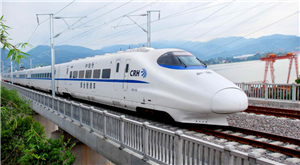China’s high-speed rail: the rapid growth of a new travel option
chinagate.cn, December 19, 2014 Adjust font size:
China has the world’s largest and still expandinghigh-speed rail (HSR) network, but whether ridership would materialize has been the subject of much debate. A new World Bank paper finds initial traffic volumes are promising, with traffic growing from 128 million trips in 2008 to 672 million trips in 2013 and over 2.9 billion passengers having taken a high speed train trip between April 2007 and October 1st 2014.
The paperunderlines that the circumstances in China in terms of long distances, high population density, well interspaced large cities, and its economic rebalancing strategies are propitious for the long-term success of HSR.By focusing on understanding and addressing passenger needs, as well as efficient and effective operation, traffic can be expected to continue rapid growth over the coming two decades.
The paper titled High-Speed Railways in China: A Look at Trafficlooks atChina’ s HSR traffic in a global perspective and presents case studies of one of the country’s busiest routes and a relatively lightlyused intercity routeto illustrate how passengers have responded to new HSR services.
China has over 12,000 kilometersof passenger-dedicated high-speed rail in operation. In the summer 2014, China Railways was running over 1,330 pairs of high-speed trains a day on both this dedicated network and on upgraded conventional lines. More lines are being built and upgraded to connect all cities of more than 500,000 people through rapid rail by 2015.
In 2013, China’s high-speed rail lines carried more passenger-kilometers(214 billion) than the rest of the world combined, about 2.5 times the volume in Japan and four times the volume in France. Traffic densities of 22.5 million in 2013compare favorably to levels reached by Japan and France at the same stage of development.
The paper examines who is using HSR, whether the service has benefitted ordinary citizens, and how it has affected personal mobility by using survey data collected from passengers along the Changchun-Jilin and Tianjin-Jinan corridors. The survey was carried out by the World Bank,China Railway Corporation and the ThirdRailway Survey and Design Institute.
Survey findings indicate that a large proportion of high-speed trainpassengersare between the ages of 25 and 55, with many using the HSR for business travel. A broad range of travelers of different income levels choose HSR for its comfort, convenience, safety and punctuality over existing alternatives. The survey found that the average income of high-speed train passengers was 35-50 percent higher than that of conventional train passengers.The majority of surveyed passengers (50 to 70 percentof users in the two case studies) reported income of less than RMB5,000 per month. Users perceive HSR as facilitating reunions with family and friends, tourism, and access to job opportunities. High-speed railalso has had a marked impact on local businesses and personal mobility of their employees.
“Understanding and addressing passenger needs are critical to achieving the full impact of the high-speed rail network. While initial results are encouraging, high-speed rail remains a major investment that requires high traffic density to be justified economically and financially,” said Gerald Ollivier, a World Bank Senior Transport Specialist and co-author of the paper.
“This can be achieved by working closely with cities to develop areas around stations in a way that leverages the gain in accessibility that high speed rail provides.It also important to optimize train frequencies and city pairing, introduce flexible ticket prices reflecting peak and off-peak periods, and introduce convenient e-ticketing services. By focusing on these aspects, and on the efficient and effective operation of the network, high-speed rail in China can continue to experience substantial growth for many years to come,”he added.
This paper is partof the China Transport Note Series produced by the World Bank in Beijing to share experience about the transformation of the Chinese transport sector. The World Bank has supported six railway projects with design speeds ranging from 200 km/h to 350 km/h in China.


